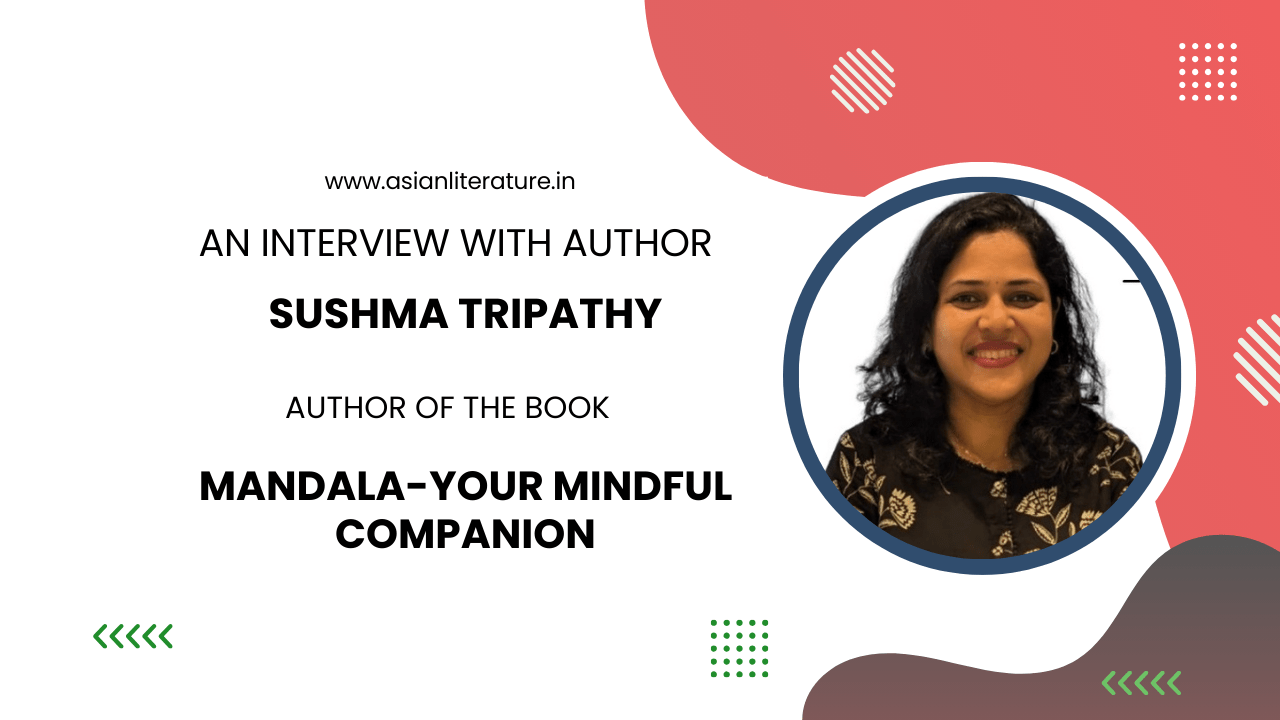
Sushma Tripathy
Sushma Tripathy
Writer. Editor. Mandala Art Consultant. Talk Show Host.
Through her brand Sacred Strokes, she combines the art of mandalas with soulful storytelling to create experiences that inspire stillness, reflection, and self-connection.
She believes that art doesn’t have to be perfect; it just needs to be present.
This journal is her invitation to you:
Let your lines flow. Let your thoughts breathe. Let yourself come home.
1. What inspired you to create Mandala – Your Mindful Companion? Was there a personal experience that sparked this journey?
Sushma Tripathy: To answer it, let me go the reverse way. I would answer the second question first. Mandala and I share a very deep connection. I discovered this connection only after I had been drawing mandalas for quite some time. As I have also mentioned in the journal book, the Mandala happened to me during the pandemic when I was in search of a “Meaningful identity”. Over time, I came to realize the power it holds, the meaning it reflects, and how it’s everyone’s, yet each one’s connection to the mandala is unique. I truly believe that Creative expression is the best way to create a deeper connection, and mandalas are one of those creative modes that have worked for me.
And that brings us to the inspiration behind the journal- Mandal- Your Mindful Companion. The way Mandala helped me, held me, guided me, and stood by me as a part of my personal growth, I visualize and believe that this journal is one such companion for the seekers. That’s why the tagline is- A Journal of thoughts for every soul, seeking Mindfulness & Self-Discovery.
2.Your book blends art, mindfulness, and spiritual insight beautifully. How did you arrive at the idea of using mandalas as a tool for self-discovery and healing?
Sushma Tripathy: When I started drawing Mandalas, I followed a familiar pattern: searching on Google, drawing it, rushing to finish the design, and then admiring what I had created.
In no time, I realized that my quest was not for the patterns in Google; my search for a mandala was a part of me trying to discover myself. As I worked, I slowly realized that the pieces I created, which sometimes involved brainstorming and other times followed an intuitive flow, reflected the state of my mind and how my creative expression was guiding me. Usually, people read about something and then try it. I did it the other way around. I started drawing mandalas because they were “trending,” and then I went on to study them more and more.
Mandalas have always been more than art. In the Vedic tradition, the Sri Yantra was seen as a diagram of cosmic harmony. Tibetan monks use sand mandalas to meditate on impermanence. And even in psychology, Carl Jung found mandalas to be mirrors of the self. For me, these traditions reaffirmed what I was experiencing personally, that mandalas are not about perfection, but about wholeness and healing.
3. Many people associate mandalas with complex art or religious symbolism. How do you make this practice approachable for someone with no artistic or spiritual background?
Sushma Tripathy: Yes, you are right. Mandala is often connected to art, spirituality, religion, and psychology. If you ask me, I am no expert in any of these departments, per se. Yes, I practice and draw mandalas, and as a Mandala Art Consultant, I understand that there is still so much to be discovered. Now, to answer what this common belief is, let me share something here which may help our readers to relate:
We all have seen a seashell, right? What does it look like? Spiral, correct! That spiral has a tiny centre, and it opens or unfolds as it expands. Now you may find the shell rigid at its first appearance, but when you follow that little dot in the centre, it was (something) in motion. Now that “something” can be your emotions, can be how you see drawing as a skill, or art, or a tool to express, or your me-time..the choice is yours. So the act of creating a mandala becomes that quiet listener for you.
So I didn’t use any complex patterns or spiritual context to explain, but you understood what I meant to say.
That’s why I say, you do not have to be an artist or from a particular background. You just need a willingness to explore Mandala, and then just put your trust into it; the rest of Mandala will take care of itself!
4. You’ve included mood quizzes, chakra-based coloring prompts, and reflective journaling exercises. How did you decide on the structure of the book and the flow of activities?
Sushma Tripathy: Frankly speaking, one journal book is insufficient to highlight and present the different layers of the mandala fully. For this journal, I aimed for a simple approach that is fundamental in its appearance and not too overwhelming for first-time users. The Chakras and the circles emerged organically during the book’s drafting process. And when I see it now, it makes so much sense and kind of binds the journal’s intention and expression so well. Trust me when I say this: editing your work is a very tough job. I had to put on the lens of a journal user and ask myself multiple questions, which is how the book ended up with its structure- easy to follow, fun to color, and gentle, whether it’s the quiz or the reflection prompts.
5. What role has mindful art played in your own life? Can you share a personal moment when mandala journaling helped you navigate a difficult time?
Sushma Tripathy: Oh, I can speak at length on this! But I would keep it short and relevant so that people can understand. As I mentioned earlier, the Mandala happened to me during the pandemic, when I needed it most, and I didn’t even realize it. At that time, I was looking to work on myself, guided by an inner voice that kept asking, “What are you doing for yourself?” What do you wish to do for yourself? Where should you begin? And that’s when I found my coach for life, and together we started working on myself.
Mandala gave me a purpose, something I started looking forward to, something I could spend hours doing, and not complain. It is like visual journaling for me when I am drawing a mandala. I remember once I was creating something on a black art sheet. I was at the initial stage of drawing the mandala grid. And I couldn’t pull it. It felt like it was testing my patience. I stopped and stepped away. When I returned to the same sheet. I drew the entire page as half gridded and half free-flow mandala. I learnt that day that the awareness I have and how I see it visually guided me through not doing and returning when I am ready. IT’S like journaling happening in real time!! Isn’t it?
6. The book speaks to self-acceptance, letting go of perfection, and embracing ‘imperfections’ as part of our stories. How do you personally practice that in your creative life?
Sushma Tripathy: Perfection is what you perceive. Right? What may look perfect to me may seem flawed to you. This reminds me of a question from one of the mandala workshops I took, where a participant asked, “Are there more varieties in the patterns that we can draw?” What if I am not able to pull it off perfectly? What if it doesn’t look ‘perfect’ once completed? These were her questions, and my answer was- Mandala is never about the end product being perfect, it’s about how well you soak in the process of creation.
I also started with the same doubts, but as I learned and became aware, I realized that what I draw is not just art; it’s a concept used in many ways, and one form is art. And this belief helped me as a writer as well. It gave me the voice I needed for myself. Whatever I do, I create, present, and accept myself as a creative person, first in my natural state. I don’t let fear of imperfection stop me from creating, knowing that creativity often comes with imperfections. So, yes, I make mistakes, I get feedback, and I work along with my imperfections. Sometimes I take my time to accept them, and other times they come very easily. However, I practice all the principles mentioned in the journal book, and I know how important they are for understanding oneself.
7. Which chapter or section of the book is closest to your heart, and why?
Sushma Tripathy: That’s a difficult one!! Still, the Mandala quiz and the cosmic blueprint were something that, when they came on paper, I was startled by, thinking how diverse one concept can be!!
8. You’ve included a wonderful symbol dictionary at the end. How do you recommend readers personalize their mandalas with these meanings?
Sushma Tripathy: Oh, yes, that is an interesting one!! Good that you asked! So, when I first thought about it, I decided to give icons and their meanings, and that’s it. But then I thought, if I were someone who might come up with a question, I’d be on a page full of circles, wondering where to draw them, since each symbol has a meaning. That’s when the suggested use column came into place. And while these are just suggestions, I would recommend that the readers go with their instant connection with a particular symbol and how and where they wish to place it in the circle. Overcontemplation may complicate things, and they may end up not drawing it at all. So go easy, choose what you like, and you will derive a new meaning from it that is uniquely yours.
9. How do you envision readers using this journal over time? Is it something to revisit regularly, or do you see it as a one-time transformational experience?
Sushma Tripathy: It’s your companion- something you can return to again and again. The beauty of mandalas is that they change as you change. A prompt you attempt today might reveal something entirely different when you revisit it six months later. Transformation isn’t a one-time event; it’s layered, and the book is designed to support that ongoing journey. As I have mentioned in the journal, the pages may end, but your mandala and mindfulness journey continues, and this journal is your companion for life.
10. What message or feeling do you hope readers carry with them after completing Mandala – Your Mindful Companion?
Sushma Tripathy: Even after they complete the journal, I want the readers to remember- Keep drawing. Keep listening. Keep returning to the center. There’s more of you to meet there. Because your journey is a “Mandala” in itself.
Book Title: Mandala-Your Mindful Companion
Author: Sushma Tripathy
Publisher: Evincepub Publishing

